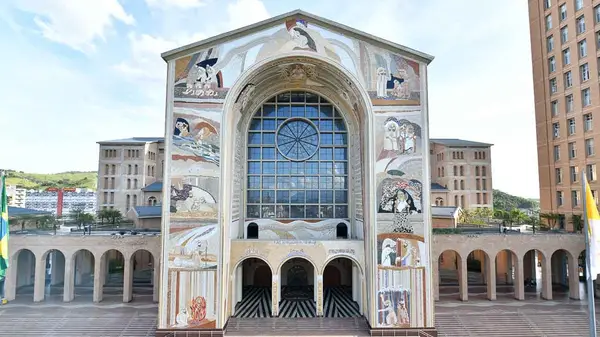Enormous Rupnik project put on hold
"Inauguration of the north façade, the other three sides of the church remain unfinished".
Abuses contaminate it: Brazil's Aparecida shrine halts Rupnik's mosaics for the moment
"Rupnik himself has always insisted that they are two closely related elements".
"The famous Slovenian artist, who is accused of having abused more than 21 victims between the years 1980 and 2018, has just been expelled from the Society of Jesus, but not from the priesthood"
The mosaics depicting 110 biblical passages are intended to cover the four sides of the temple, with the aim of transforming the external face of the basilica into one of the "largest open-air Bibles" in the world.
Once the north façade was inaugurated, the other three sides of the church remain unfinished. While awaiting the final word on the matter from the bishop of Aparecida Archbishop Orlando Brandes
Art is an expression of the artist's soul, it reflects his personality. It cannot be said that art and ministry are two separate things. Rupnik himself has always insisted that they are two intimately related elements. The Brazilian Church understands that former Jesuit Marko Rupnik's status as an abuser is related to his art. And for this reason, it is suspending the creation of his mosaics on the façade of the national sanctuary of Our Lady of Aparecida.
As reported by Fernanda Rodrigues on the Itatiaia portal, the Brazilian sanctuary declares that it "is following the case (of Rupnik) closely and is awaiting the final decisions of the Church". The famous Slovenian artist, who is accused of having abused more than 21 victims between 1980 and 2018, has just been expelled from the Society of Jesus, but not from the priesthood.
In 2018, the Brazilian Basilica, the Marian soul of the country, approved a project entitled "Biblical Journey" for the façades of the sanctuary. It consists of mosaics depicting 110 biblical passages intended to cover the four sides of the temple, with the aim of transforming the external face of the basilica into one of the "largest open-air Bibles" in the world.
Following Rupnik's guidelines, the mosaics are made of natural stones, such as marble and granite, and handmade Venetian glass. The pieces are of diverse origin: there are Brazilian, Mexican, Belgian, Portuguese, French and Egyptian stones, among others.
The first mosaic, which covers the north façade of the Basilica, was completed and delivered on 19 March last year. The work is inspired by scenes from the book of Exodus. On the south side of the temple, the Passover of Christ is depicted, on the east side, Genesis, and on the west side, the Apocalypse.
The work began in 2019 and has so far involved more than 177 professionals. Among them, 27 mosaicists of different nationalities, linked to the Aletti Centre in Rome, linked to Marko Rupnik.
The work, considered to be the largest sacred art project in the world, is currently at a standstill. While the north façade has been inaugurated, the other three sides of the church remain unfinished. The bishop of Aparecida, Archbishop Orlando Brandes, who has presided over the archdiocese, to which the sanctuary belongs, since 2016, is awaiting the final word on the matter.











.jpeg)

Comments